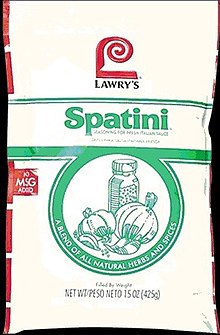Spatini sauce mix is a dry, packaged seasoning mix produced by Lawry's.[1] Originally developed in 1952 to be added to other ingredients (such as crushed tomatoes or tomato puree, and ground meat) to make an Italian-style "spaghetti sauce", it is also used variously to make a dip, in meatloaf, to season meatballs, and more.
 Commercial-sized 15 oz. Spatini package | |
| Type | Seasoning mix |
|---|---|
| Place of origin | United States |
| Region or state | Philadelphia, Pennsylvania |
| Created by | Russell G. Lakoff and Harry Seidman |
| Invented | 1952 |
| Main ingredients | Salt, sugar, onion, potato starch, spices (including red pepper, turmeric, black pepper), corn maltodextrin, garlic, beet (color), dextrose, yeast extract, guar gum, and carrot |
Its formulation includes (in descending order by weight) salt, sugar, onion, potato starch, spices (including red pepper, turmeric, black pepper), corn maltodextrin, garlic, beet (for color), dextrose, yeast, guar gum, and carrot.[2]
The mix was manufactured and distributed originally by Spatini Co., subsequently by Unilever and its subsidiary Lipton Foods, prior to Lawry's, a subsidiary of spice giant McCormick Co.
History
editSpatini spaghetti sauce mix was originally developed and marketed by Russell G. Lakoff and Harry Seidman of Overbrook Hills, Pennsylvania, who registered their business in Philadelphia as Spatini Co. on September 4, 1952,[3] selling the dry powdered mix packaged in boxes of three packets.
The Spatini Co. also manufactured a brown gravy mix that was sold under the Spatini brand.[4] In 1962, Spatini spaghetti sauce added a version with tomatoes already included,[5] which was discontinued.
Lipton, an Englewood Cliffs, New Jersey, subsidiary of Unilever, purchased Spatini Co. in 1976, and took over the manufacture, distribution, and marketing of the Spatini brand. Unilever shifted it from Lipton to its subsidiary Lawry's line in the mid-1980s,[6][better source needed] and Lawry's continued to promote and sell Spatini spaghetti sauce mix for home consumers, and introduce new recipes using the mix for commercial users.[7]
Retail manufacturing of Spatini spaghetti sauce mix for home consumers ended in January 2007,[8] but it continues to be manufactured and distributed commercially for restaurant and institutional use[9] by Lawry's, which was sold by Unilever to McCormick & Company in 2008.[6][better source needed]
Ingredients
editAt some point prior to the 1980s ingredients in earlier versions of Spatini spaghetti sauce included (in descending order by weight) sugar, salt, dehydrated onions, potato starch, spices and herbs, artificial color (beet and carrot powder), egg white powder, whey, monosodium glutamate (flavor enhancer), natural flavor, and vegetable gum.[6][better source needed] In the 1980s, Spatini spaghetti sauce listed ingredients as sugar, salt, dehydrated onion, potato starch, spices, natural flavors (contains dairy), garlic powder, maltodextrin, beet powder (for color), autolyzed yeast extract, and guar gum. In 2017, the listed ingredients for Spatini spaghetti sauce include salt, sugar, onion, potato starch, spices (including red pepper, turmeric, black pepper), corn maltodextrin, garlic, beet (color), dextrose, yeast extract, guar gum, and carrot.[10] In 2022 the formulation was salt, sugar, onion, potato starch, spices (including red pepper, turmeric, black pepper), corn maltodextrin, garlic, beet (for color), dextrose, yeast, guar gum, and carrot.[2]
Nutritional information
editThe commercial version of Spatini spaghetti sauce mix lists a serving size of two teaspoons or six grams, which seasons a half cup when prepared. One serving contains 20 calories, 620 milligrams of sodium (26% Daily Value), 2 grams of sugars, 4 grams of carbohydrates (1% Daily Value), with no fat, protein, cholesterol, or fiber.[10]
Marketing
editSpatini spaghetti sauce began to emphasize television advertising in 1964, when the company shifted its advertising agency from Weightman, Inc., to Firestone-Rosen, Inc.[11] Because Firestone-Rosen had conflicting assignments from the Ronzoni company,[12] Spatini moved its account to Ron Bloomberg Advertising in 1969,[13] after which Spatini was advertised on broadcast media[14] by singing the words "Spatini spaghetti sauce" to the tune of "La donna è mobile" from the opera Rigoletto.[15][16]
References
edit- ^ "Spatini Details". TrademarkBank. Retrieved June 10, 2017.
- ^ a b Spatini, at Lawry's (2022)
- ^ "Spatini Co". CompaniesPA. Retrieved September 25, 2016.
- ^ "Philadelphia's Spatini Co. Appoints Firestone-Rosen". Sponsor. 18. Sponsor Publications: 56. 1964. ISBN 0-19533-553-8. Retrieved September 25, 2016.
- ^ "New Products: Spatini Mix with Tomatoes". Super Market Merchandising. 27. Super Market Publishing Company: 93. 1962. Retrieved September 25, 2016.
- ^ a b c Pollard, Garland (September 14, 2010). "Fan of Spatini Speaks Out". BrandlandUSA. Retrieved June 10, 2017.
- ^ "New Recipes for Spatini". Restaurant Business. 83: 56. 1984. Retrieved September 25, 2016.
- ^ Marcus, Erica (March 21, 2007). "Burning Questions: Can this sauce be duplicated?". Newsday. Archived from the original on June 15, 2020. Retrieved September 15, 2016. Alt URL[dead link]
- ^ Rothman, Julie (July 6, 2010). "Recipe: Shortcut Lasagna - A reader was looking for a lasagna recipe she got off a Spatini spaghetti sauce mix box". The Seattle Times. Retrieved June 8, 2017.
- ^ a b "Lawrys Spaghetti Sauce, Spatini". McCormick for Chefs. Retrieved June 10, 2017.
- ^ "Agency appointments..." (PDF). Broadcasting. July 6, 1964. p. 42. Retrieved June 10, 2017.
- ^ "Directory". Editor & Publisher. 102: 67. 1969. Retrieved June 10, 2017.
- ^ "Business briefly". Broadcasting. 1969. p. 26. Retrieved June 10, 2017.
- ^ "Selling Sounds". Billboard. March 14, 1970. p. 29. Retrieved June 10, 2017.
- ^ Greenwald, Helen M., ed. (2014). The Oxford Handbook of Opera. Oxford University Press. p. 948. ISBN 9780195335538. Retrieved June 10, 2017.
- ^ Sorba, Carlotta (November 2009). "Attila and Verdi's historical imagination". Cambridge Opera Journal. 21 (3): 341–348. doi:10.1017/S0954586710000145.
External links
edit- Lawry's Spaghetti Sauce, Spatini, product page on manufacturer's website
- spatini.info, a current source for Spatini sauce